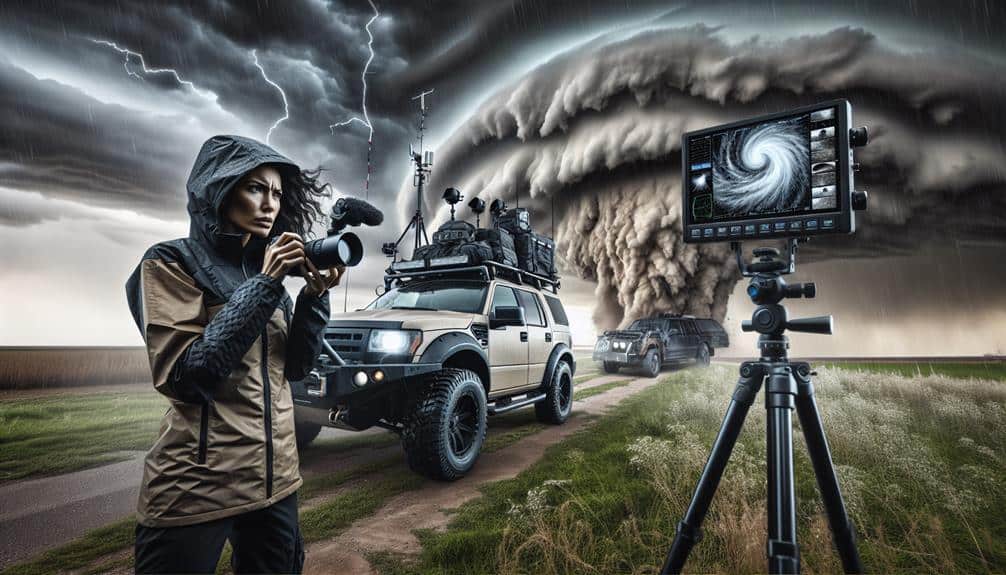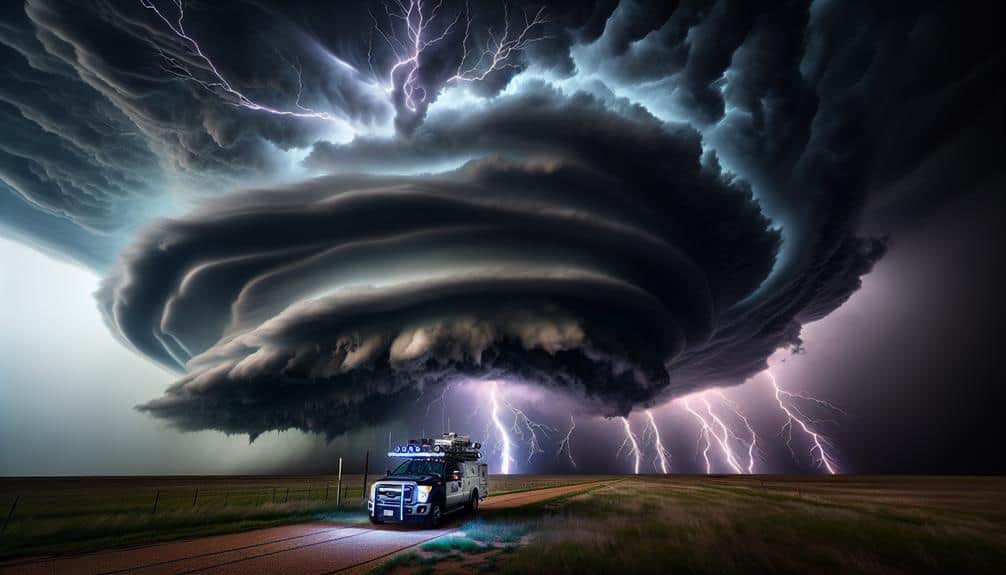Capturing the awe-inspiring drama of supercell storms requires a mix of technical skill, safety awareness, and creative vision. First, we need weather-resistant gear and adaptable lenses. Understanding storm structure helps us anticipate the best moments amidst rotating updrafts and wall clouds. We should master our camera settings for varied lighting, using manual focus and burst mode. Positioning safely yet strategically allows us to capture impactful angles, leveraging natural light for dynamic shots. Ultimately, editing should enhance storm intensity and fine details without losing authenticity. If we focus on these tips, we can elevate our storm photography to the next level.
Key Points
- Use a wide-angle lens to capture the full structure of the supercell storm.
- Opt for a weather-resistant camera body to protect against harsh conditions.
- Adjust exposure manually and use lower ISO to reduce noise in changing light.
- Position safely with an escape route, understanding storm paths for optimal shots.
Selecting the Right Gear
When preparing to photograph supercell storms, we must select gear that can withstand harsh weather conditions and capture high-quality images. Our camera lenses should be adaptable, allowing us to adjust to rapidly changing scenes.
A wide-angle lens is crucial for capturing the vast structure of the storm, while a telephoto lens aids in magnifying distant lightning strikes and tornado formation.
Equally essential is the ruggedness of our camera body. Weather-resistant models are essential, as they shield against rain, dust, and strong winds. We also require robust tripods to maintain stability in spite of the gusts.
Weather apps are our greatest allies. By utilizing them, we can monitor storm progression and plan our shots accurately. Apps such as RadarScope offer up-to-the-minute radar information, empowering us to anticipate when and where the most impactful moments will occur.
Our safety gear mustn't be disregarded. Waterproof bags and lens covers safeguard our equipment, while portable power banks guarantee our devices don't malfunction at crucial moments.
Let's also remember personal safety: durable boots and weatherproof clothing keep us safe while pursuing these astonishing natural occurrences.
Understanding Storm Structure
Equipped with the right gear, we must now focus on comprehending the anatomy of supercell storms to capture their most dramatic moments effectively. Understanding storm structure is key to predicting where and when the most photogenic elements will occur.
Supercells are characterized by their rotating updraft, known as a mesocyclone, which gives rise to distinct cloud formations. These dynamic structures often produce stunning wall clouds and the awe-inspiring anvil shape, both prime subjects for our lenses.
We need to pay close attention to wind patterns. The interplay of updrafts and downdrafts can signal the onset of severe weather, including lightning and heavy precipitation. Lightning often strikes near the updraft, offering a spectacular, albeit dangerous, visual element.
Capturing these moments requires that we remain vigilant and ready to adjust our positions swiftly.
Let's not forget the role of precipitation. The heaviest rain and hail typically fall from the downdraft regions. Understanding this helps us avoid being caught in hazardous conditions while still getting those dramatic shots.
Mastering Camera Settings
To capture the raw power of supercell storms, we've got to master our camera settings for best exposure, focus, and timing.
First, exposure control is essential. Supercells often present a wide range of lighting conditions, from bright lightning to dark, menacing clouds. We'll need to use manual mode to adjust our ISO, aperture, and shutter speed dynamically. A lower ISO will reduce noise, while a mid-range aperture (around f/8 to f/11) offers a deep depth of field, capturing more detail in the storm structure.
Next, focus techniques are key. Auto-focus can struggle with the low contrast and rapidly changing scenes of a storm. Switching to manual focus allows us to keep the storm sharp. By focusing on a distant object, such as a tree line or a specific cloud formation, we can make sure that our images remain crisp.
Timing is everything. Burst mode allows us to capture multiple shots in quick succession, increasing our chances of catching that perfect lightning strike or dramatic cloud movement. We should also consider using a tripod to stabilize our shots, especially during long exposures, which will help us achieve the sharpest images possible.
Mastering these settings frees us to focus on the mesmerizing power of nature.
Positioning for Safety and Impact
Positioning ourselves strategically guarantees not only the most dramatic shots but also our safety in the face of unpredictable supercell storms. When we're out in the field, weather knowledge becomes our greatest ally. Understanding storm paths and their potential intensities allows us to choose locations that provide both safety and the best vantage points.
We can't stress enough how vital it's to prioritize safety precautions—always have an escape route and keep an eye on changing conditions.
For truly impactful angles, we need to think about composition techniques. Placing the storm on the horizon can create a sense of scale and drama, while foreground elements like trees or buildings can add depth and context to our shots. If we position ourselves perpendicular to the storm's path, we capture the breadth of the supercell structure, showcasing its awe-inspiring power without putting ourselves directly in its line.
We should also use natural light to our advantage. The interplay of light and shadow in storm photography can be spectacular, emphasizing the storm's intensity. By combining our weather knowledge with smart positioning, we can capture breathtaking images that tell a compelling story, all while staying safe.
Editing and Enhancing Photos

Once we've captured our dramatic shots in the field, the next step is to enhance these images through thoughtful editing techniques that highlight the storm's raw power and intricate details. To achieve this, we'll focus on refining our photos with precision and creativity.
First up, color correction. Adjusting the hues and saturation can bring out the storm's intensity, making the clouds appear more menacing and the lightning bolts more vivid.
Next, cropping is pivotal for focusing on the most compelling parts of the image and eliminating distractions. Always keep the composition balanced to retain the visual impact.
Lighting effects can transform an image from good to breathtaking. By carefully adjusting the highlights and shadows, we can emphasize the storm's depth and texture. Filters, meanwhile, offer a quick way to apply consistent tones across a series of photos, enhancing the mood and atmosphere.
Here are some essential steps:
- Color correction: Boost vibrancy and adjust tones.
- Cropping: Focus on key elements and improve composition.
- Lighting effects: Modify highlights and shadows for depth.
- Filters: Apply consistent tones to enhance mood.
Frequently Asked Questions
What Is the Best Time of Year to Photograph Supercell Storms?
We should photograph supercell storms during late spring to early summer. Seasonal patterns and weather patterns provide ideal conditions and higher storm frequency, ensuring we capture stunning visuals while prioritizing our safety amidst these powerful natural phenomena.
How Can I Predict Where a Supercell Storm Will Form?
To predict where a supercell storm will form, we need to ride the winds of storm tracking and meteorology, analyze weather patterns, and use forecasting models. With these tools, we can chase the storm safely and effectively.
Are There Any Mobile Apps Useful for Storm Chasing Photography?
We rely on mobile apps like RadarScope for storm tracking and MyRadar for real-time updates. For camera settings, apps like PhotoPills help us plan shots, ensuring we capture the perfect storm safely and effectively.
How Do I Keep My Equipment Safe During a Storm?
We must prioritize safety while chasing storms. Use waterproof gear to protect cameras and lightning protection for tripods. Shelter under sturdy structures and avoid open fields to prevent equipment damage. Let's capture storms safely and freely.
What Are the Signs That a Supercell Storm Is Approaching?
When the sky whispers its wild symphony, we watch for towering storm cloud formations and analyze weather radar observations. These signs reveal a supercell's approach, guiding us with technical expertise and visual storytelling while ensuring our safety.


